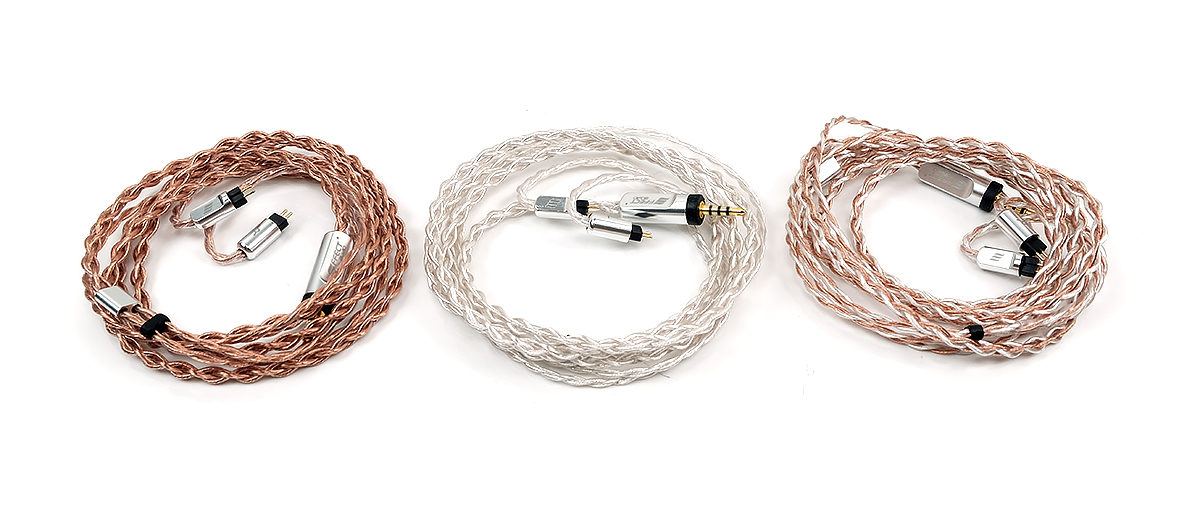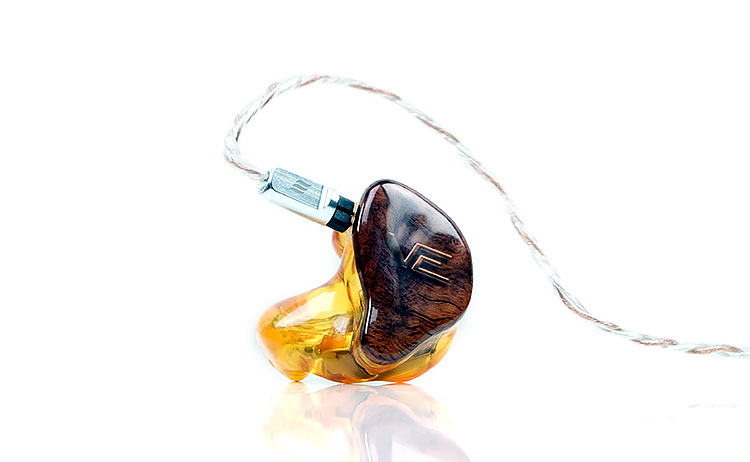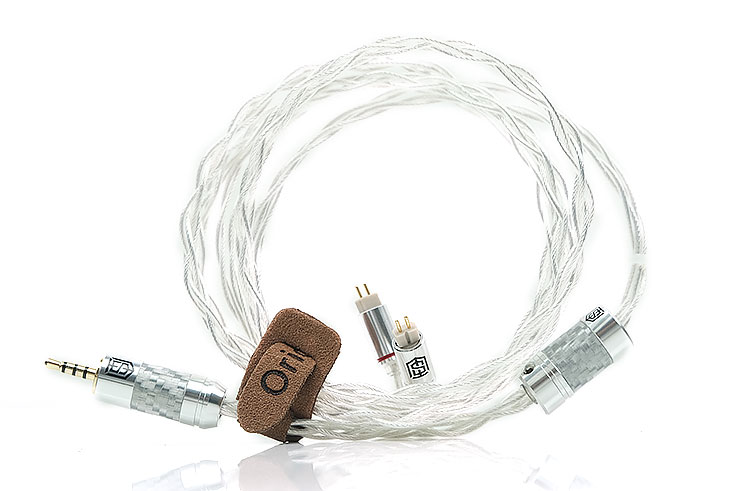Sound Impressions
Each cable has its unique signature and is fairly easy to pick out with a revealing monitor.
For the majority of the initial testing, I used 64 Audio’s Tia Trio and Hum’s Dolores, both of which I find fairly revealing with good treble performance. In the case of the Trio, you can easily pick out any subtle changes in bass performance with its excellent dynamic driver.
Maestro
If you are coming from something like a Plastics One stock cable the difference is palatable with much better dynamic range, improved treble presence, and a snappier bass performance.
The Maestro also keeps it relatively neutral to natural and not too far off the tone of the Ares II except for a few crucial and welcome differences.
The first is the bass performance of the Maestro sounding a little more impactful with better dynamic range and layering using the Trio. It is an upgrade to my ears and fairly easy to pick out even with DAPs which I find fairly bass light such as the FiiO M11.
The timbre is a touch lighter and cleaner than the Ares II though still quite smooth to my ear. instruments have a bit more pop and clarity though not quite as full-bodied as the Ares II.
There seems to be a slight upper mids and treble lift in the Maestro that delivers that slightly cleaner tone and improved separation. The resulting impression is of a really nice level of control without it sounding artificial or lean and good levels of detail.
Virtuoso
The Virtuoso distinguishes itself from the Maestro by the amount of body it injects into the tuning compared to the Maestro. There is simply more of it, with additional power, warmth, and texture in the low end of the tia Trio. That additional body also creeps up into a fuller vocal timbre and a richer instrumental note in general.
The dynamic range is just a shade better also with a more holographic dimension to the soundstage. You get a more immersive and powerful listening experience when you move from the Maestro to the Virtuoso.
The treble is smoother than the Maestro, a bit wetter with more body-to-percussion timbre. I actually love the mids and treble performance of the Virtuoso and takes a bit of the sting out of the M11/Dolores treble performance, (without any loss of detail), which can sometimes sound a bit digital for my preferences.
Grandioso
The Grandioso takes the holographic presentation of the Virtuoso and some of that power but refines it a bit more, especially in how it controls the low end.
I find the warmth of the Virtuoso with the tia Trio fades a touch on the Grandioso pairing but in return, you get to hear a lot more detail right down to the sub-bass presence. It sounds more resolving, with a bit more space and separation which I think sucks you in a bit better when listening to the low end of both cables.
A good example is a bit of a ‘nonsense’ track from Grimes called Dragvandil off her ‘Halifaxa’ album. It is not a terribly musical track, more left-field and introverted but it has this killer kick-drum underlying rhythm driving the pace right throughout.
Now on the Virtuoso using the tia Trio, I get a bit more warmth but it sounds a little close, a little more “one-dimensional” in its texturing.
The Grandioso delivers something a bit more natural sounding but with excellent separation and a slightly more refined level of detail. The Virtuoso is fun on the low-end but the Grandioso, I guess you call it more ‘audiophile’ in how it handles the bass, a shade more accurate.
That theme travels up throughout the mids and treble with the Virtuoso offering a bit more warmth and smoothness but the Grandioso pulls in the separation of the Maestro a bit more and delivers something more intricate and resolving.
The Grandioso sounds more accurate in its timbre and imaging with the tia Trio so if you fancy a bit of monitoring or want to switch to a complex orchestral offering this is the best choice of the three.
Synergy
Three cables with unique signatures and you can pretty much take your pick depending on your preferences for pairing with monitors and DAPs.
Maestro
The Maestro is what I would call a good-performing universal cable, excellent for first-time upgraders but a little shy of low-end weight. It suits monitors that would be off-balance a little if the low-end was overcooked such as the Empire Ears Phantom of Vision Ears VE4.2.
The Maestro also has a nice treble sparkle and some upper mids “pop” which might be of appeal to Phantom owners who feel the vocals could be teased out a little more. I also liked it with the Vision Ears 4.2 which is V-shaped and doesn’t need any more bass emphasis. This pairing had a nice level of clarity in the mids which a V-shaper can often need.
Virtuoso
If you want to maximize the low-end weight then the Virtuoso is the sweet spot out of all three cables. You can plumb up the low end and go for something a bit more musical with the Virtuoso. I actually enjoyed it with the 64 Audio A18 and the Delores in particular.
Both of these have more delicate presentations at times and for some a bit sterile for impact. The Virtuoso won’t change them into bass head machines but there was a pleasing level of richness from these pairings as well as a bit of a wetter treble response.
Grandioso
For me, the Grandioso makes sense once you start bringing in resolving monitors, the less forgiving ones that need maximum clarity and separation to shine.
In a way, it is as flexible as the Maestro just much more resolving with a shade more treble than the Virtuoso and more weight on the low end to deliver the best balance and accuracy of the three cables.
Monitors such as qdc’s excellent VX and the tia Trio sounded extremely good with the Grandioso. You get a lovely balance in the treble timbre of these two monitors with good weight also on the low-end to tease out a fairly holographic soundstage.
Select Comparisons
We used the 64 Audio tia Trio with a FiiO M11 and some FLAC test tracks, a mix of electro-synth of Trevor Something, and the more aggressive pop of Grimes for the comparisons.
I wanted to get a full range of bass presence, strong vocals, and higher frequency synth performance going as the tia Trio does an excellent job of stretching the soundstage.
Effect Audio Ares II
$149.90
Technical
The Ares II is EA’s entry-level Premium Series cable. This is also a 1.2m 26AWG cable, much like the Vogue Series trio, and also uses a UPOCC Litz Copper wire in line with the cheaper Maestro Vogue cable.
The price difference makes this a very attractive comparison. There is no triple-size multi-stranding on the Ares II which uses two sizes rather than 3 inside the Maestro.
The Maestro is noticeably smaller and lighter than the Ares II with a slightly stiffer PET jacket though visually the coloring and tones of the copper shine through nicely on both.
The Ares II also uses bulkier and heavier barrels with the older style jack and connector encasings. Both handle quite well and both are very low for microphonics. The Maestro, however, being the lighter of the two is the comfier cable.
I do prefer the newer lighter craftsmanship of the Vogue series barrels to be fair but the Ares II right-angle jack is made of strong stuff and is very durable.
One important thing to note is that the Ares II has a much wider selection of barrel, jack, and connector choices so you can customize a bit more and perhaps shed some of the weight.

Performance
The gap between these two cables is not huge and given the $50 difference in their prices, that bodes well for the Maestro. Both are relatively smooth but as I have mentioned a few times before the Ares II is more on the neutral side of things and doesn’t do the thick rich copper meme.
The Maestro kind of follows a similar path to the Ares II but the separation on the low end seems a touch easier to pick out than the Ares II’s performance.
The Ares II’s bass seems a touch softer and not quite as dynamic sounding. You could argue that the Ares II’s low-end might have a little more warmth but it does not seem as tight and defined with the Trio as the Maestro.
Mids and treble also have a little more clarity and sparkle on the Maestro whereas the Ares II has a richer sound but with a little less separation and not quite as much air in comparison. Vocals have a bit more pop and odd-harmonic fusion with the Maestro sounding vivid and clean.
The Ares II is a touch more relaxed, with not quite as much separation, and dare I say it details also but a bit more body.
BTG-Audio Starlight
$125
Technical
The Starlight is an old-school competitively priced 1.2m 19-strand 26AWG silver-plated OFC (oxygen-free copper) wire. This is a good comparison with the Virtuoso Vogue line cable as the price points are not too far off and both use an SPC. The Starlight, however, is not a Litz wire build as far as I know, unlike the Virtuoso.
Both look radically different in their build design and approach. The Starlight wire also has a silver overtone but is insulated with a clear Linear low-density polyethylene (LLDPE) finished in a milloit braid pattern.
The wire up to the splitter barrel is also wrapped in black nylon down to the 2.5mm TRRS Eidolic jack.
The Starlight feels a little stiffer and harder to handle than the Virtuoso beyond the splitter but below it is fairly flexible as the nylon jacket dampens that flyaway nature of the LLDPE insulation.
The Eidolic jack is excellent on the Starlight but being a 3rd party component the whole finish including the heat-shrunk splitter terminal is more DIY in tone. The Maestro barrels look professional, harmonious in design, and of course much smaller and lighter.
Dynamic Range
Oh, huge difference in these 2 SPC cables and you will notice where those differences are right away. First, the overall dynamic range and volume levels seem slightly better on the Virtuoso and that may point to a higher level of resistance in the SPC wire inside the Starlight.
Timbre
The second is the richness and texture of the Virtuoso timbre. There is more of it with a stronger low-end presence enhancing the depth of the soundstage in the process.
The Starlight is much more neutral sounding with very little comparative bass impact. This, in turn, lightens the timbre making it a clean, leaner sound. You get some excellent articulation but you lose some needed weight and authority to instrumental notes, particularly lower down.
Vocals also seem leaner, sharper, and brighter on the Starlight whereas the Virtuoso benefits from a bit more low-end warmth and openness from that enhanced dynamic range performance.
Treble on both are articulate and well extended but again, the Starlight sounds a little more brittle when paired with the Trio. The Virtuoso injects a more liquid full-bodied tone to the Trio’s treble which is exactly how I like it.
Staging
The last point is staging depth and width. I like the height and energy of the Starlight treble and it seems airy enough. However, compared to the Virtuoso the staging on the Starlight seems a bit narrow in comparison with the Trio.
That all-important depth is missing on the Starlight/Trio pairing which robs the presentation of some 3-dimensionality compared to the Virtuoso.
Satin Audio Medusa
$209.90
Technical
The Medusa is a pure silver 4-wire rather than a hybrid, SPC, or copper. However, because of the really hot price point just $10 more than the Grandioso, I thought it would be worth comparing the two to see how they perform.
The Medusa is a 1.2m 26AWG Type 4 Litz wire OCC pure silver build with a rating of between 6 and 7N for purity. The finishing is called a ‘SA’ jacket but we think it’s a PE translucent jacket with a strong silver overtone from the wire underneath showing through.
The grandioso is also 26AWG but not a Type 4 Litz specifically and uses UC-OCC copper and silver braided together in a 2×2 wire split. There is no mention of multi-stranding for the Medusa or Golden Ratio which the Grandioso uses in its geometry.
The EA UltraFlexi jacket is a softer PVC with a tighter braid compared to the longer throw of the Medusa design. The Medusa barrels and connectors are beautifully harmonious with their matching silver chrome and carbon fiber weave prints.
No doubt the Medusa is a more striking cable to look at compared to the Grandioso. However, it is a little lighter, slightly higher in microphonics above the splitter but has the same performance as the Grandioso. The Grandioso uses memory wire and the Medusa does not which might explain some of the additional nuance noise above the splitter.
You also get a lot more termination jack and connector choices with the Medusa and a nice little satin pouch with an IEM organizer compared to the plainer packaging of the Grandioso.
Performance
There were some definite differences between these two cables, particularly in low-end bloom, and how forward the mids and lower treble made their presence felt.
Bass weight
The first key difference was the bass weight towards the sub-bass region. The Medusa reached a bit deeper and gave me a bit more of it compared to the slightly more neutral mid-bass bias of the Trio/Grandioso pairing.
The Grandioso was quite punchy but a little more linear on the low end to my ear and not quite as warm sounding. Instead, it offers a bit more separation and a slightly tighter delivery.
Mids/Treble
The second contrast in their tuning is the forwardness of the upper mids of the Trio tethered with the Grandioso, particularly vocals.
The Medusa was a little more neutral with Grimes’s vocal delivery. It still captured excellent detail but was not quite as clean and energetic as the Grandioso paired with the Trio. Instead, it is a little sweeter, softer, and more euphonic in its timbre with the Trio.
Once you move into the treble the Grandioso has a bit more energy and sparkle compared to Medusa’s smoother wetter approach.
That’s not to say the Medusa is rolled off, not at all. In fact, it does seem to project a slightly wider and more complex soundstage on the Trio despite the slightly better sparkle and treble presence on the Grandioso. The Grandioso is the attention grabber though for upper mids sparkle and vocals.
Our Verdict
I am glad EA has ushered in the Vogue Series with the entry-level upgrader in mind. The likes of Satin Audio and some cables even from the likes of FiiO have grabbed a sizeable sub $100 market share and this is a very good response to changing market conditions.
The Maestro is good enough to make stock cables like Plastics One a thing of the past with far better and smoother performances than those compressed cheapies. I would not be surprised if this cable shows up in a high-end custom monitor offering package shortly given its flexibility and value to performance.
Yet, at the same time with the launch of the Grandioso, for example, there is enough on the plate to satisfy more demanding audiophiles who want a quality performing and accurate sounding cable without breaking the bank. They are good enough to bring something new and interesting to the presentation of most quality monitors.
I suspect the musicality of the Virtuoso and the accuracy of the Grandioso might eat a little into the sales of their original bread-and-butter cable, the Ares II but hey, that’s the price of progression and new competitive threats. No one can ever stand still these days if they want to remain relevant.
Effect Audio Maestro Specifications
- 26 AWG
- Selected UP-OCC Pure Material
- Golden Ratio Dispersion, Triple-Size Stranded Design
- Woven Kevlar-infused multi-stranded Litz
- EA UltraFlexi Jacket
- EA Custom Designed Connector and Y-Split
Effect Audio Virtuoso Specifications
- 26 AWG
- Selected UP-OCC Pure Material
- Golden Ratio Dispersion, Triple-Size Stranded Design
- Woven Kevlar-infused multi-stranded Litz
- EA UltraFlexi Jacket
- EA Custom Designed Connector and Y-Split
Effect Audio Grandioso Specifications
- 26 AWG
- Selected UP-OCC Pure Material
- Golden Ratio Dispersion, Triple-Size Stranded Design
- Woven Kevlar-infused multi-stranded Litz
- EA UltraFlexi Jacket
- EA Custom Designed Connector and Y-Split






